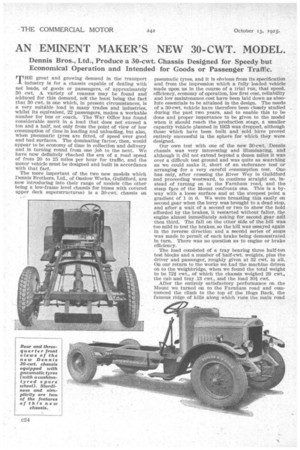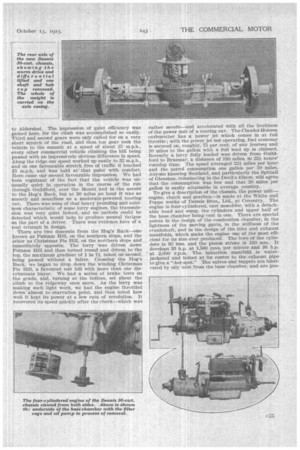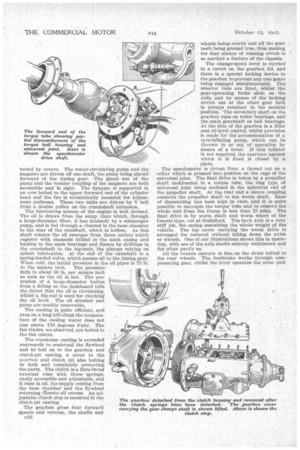AN EMINENT MAKER'S NEW 30-CWT. MODEL.
Page 8

Page 9

Page 10

Page 11

If you've noticed an error in this article please click here to report it so we can fix it.
Dennis Bros., Ltd., Produce a 30-cwt. Chassis Designed for Speedy but Economical Operation and Intended for Goods or Passenger Traffic.
T"great and growing demand in the transport industry is for a chassis capable of dealing with net loads, of goods or passengers, of approximately 30 cwt. A variety of reasons may be found and adduced for this demand, not the least being the fact that 30 cwt. is one which, in present circumstances, is a very suitable load in many trades and industries, whilst its equivalent, 22 passengers, makes a workable number for bus or coach. The War Office has found considerable merit in a load that does not exceed a ton and a half, not only from the point of view of low consumption of time ,in loading and unloading, but also, when pneumatic tyres are fitted, of speed over good and bad surfaces. The dominating factor, then, would appear to be economy of time in collection and delivery and in turning round from one job to the next. We have now definitely Aached the era of a road speed of from 20 to 25 miles per hour for traffic, and the motor vehicle must be designed and built in accordance with that fact.
The more important of the two new models which Dennis Brothers, Ltd., of Onslow Works, Guildford, are now introducing into their range of models (the other being a low-frame level chassis for buses with covered upper deck superstructures) is a 30-cwt. chassis on pneumatic tyres, and it is obvious from its specification and from the impression which a fully loaded vehicle made upon us in the course of a trial run, that speed, efficiency, economy of operation, low first cost, reliability and low maintenance cost have been laid down as absolute essentials to be attained in the design. The needs of a 30-cwt. vehicle have therefore been closely studied during the past two years, and to enable this tobe done and proper importance to be given to the model when it should reach the production stage, a smaller capacity vehicle planned in 1923 was dropped, although those which have been built and sold have proved entirely successful in the sphere for which they were designed.
Our own test with one of the new 30-cwt. Dennis chassis was very interesting and illuminating, and although it did not extend beyond a dozen miles it was over a difficult test ground and was quite as searching as we could make it, short of an endurance test or arranging for a very careful consumption test. One has only, after crossing the River Wey in Guildford and proceeding westward, to continue straight on, instead of turning on to the Farnham road, and the steep face of the Mount confronts one. This is a byway with a loose surface and at the steepest point a gradient of 1 in 0. We were breasting this easily on second gear when the lorry was brought to a dead stop, and after a wait of a second or two to show the hold afforded by the brakes, it restarted without falter, the engine almost immediately asking for second gear and then third. The fall on the other side of the hill was too mild to test the brakes, so the hill was essayed again in the reverse direction and a second series of stops was made to permit of each brake being demonstrated in turn. There was no question as to engine or brake efficiency.
The load consisted of a tray bearing three half-ton test blocks and a number of half-cwt. weights, plus the driver and passenger, roughly given at 32 cwt. in all. On our return to the works we had the machine driven on to the weighbridge, when we found the total weight to be 72i cwt., of which the chassis weighed 29 cwt., the cab and tray 13 cwt., and the load 30-a cwt.
After the entirely satisfactory performance on the Mount we turned on to the Farnham road and commenced the climb to the top of the Hogs Back, the famous ridge of hills along which runs the main road to Aldershot. The impression of quiet efficiency was gained here, for the climb was accomplished so easily. Third and second gears were only called for on a very short stretch of the road, and then top gear took the vehicle to the summit at a speed of about 25 m.p.h., every other comm,ercial vehicle climbing the hill being passed with an impressively obvious difference in speed. Along the ridge our speed worked up easily to 32 m.p.h., and on one favourable stretch free of traffic it touched 35 m.p.h. and .vas held at that point with comfort. Here came our second favourable impression. We had been cognizant of the fact that the vehicle was unusually quiet in operation in the course of the rtin through Guildford, over the Mount and in the ascent to the Hog's Back, but at 30 miles an hour it was as smooth and soundless as a moderate-powered touring car. There was none of that heavy pounding and noisiness characteristic of some lorry engines, the transmission was very quiet indeed, and no periods could be detected which would help to produce mental fatigue on the part of a driver. There was evidence here of a real triumph in design.
There are two descents from the Hog's Back—one known as Putnam Hill, on the southern slope, and the other as Christmas Pie Hill, on the northern slope and immediately opposite. The lorry was driven down Putnam Hill and then turned round and driven to the top, the maximum gradient of 1 in 7-i, taken oresee.ond, being passed without a falter. Crossing the Hog's Back, we began to drop down the winding Christmas Pie Hill, a favoured test hill with more than one discriminate buyer. We had a series of brake tests on the grade, and, turning at the bottom, set about the climb to the ridgeway once more. As the lorry was making such light work, we had the engine throttled down' almost to starvation point, and then noted how well it kept its power at a low rate of revolution. It recovered its speed quickly after the check—which was rather sevefe—and accelerated with all the liveliness of the power unit of a touring car. The Clandel-Hobson carburetter has a power jet which comes in at full throttle ; with the power jet not operating, fuel economy is secured on, roughly, 75 per cent, of any journey and 20 miles to the gallon with a full load up is claimed. Recently a lorry fully loaded was driven from Guildford to Braemar, a distance of 530 miles, in 22i hours' running time. The speed averaged 22i. miles per hour and the petrol consumption one gallon per 19 miles. Anyone knowing Scotland, and particularly the Spittall of Glenshee, culminating in the Devil's Elbow, will agree that the consumption was low and that 20 miles per gallon is easily attainable in average country.
To give a description of the chassis, the power unit— engine, clutch and gearbox—is made at the White and Poppe works of Dennis Bros., Ltd., at Coventry. The engine is four-cylindered, cast monobloc, with a detachable head and sump, the cylinders and upper half of the base chamber being cast in one. There are special points in the design of the combustion chamber, in the lightness of the moving parts, in the stiffness of the crankshaft, and in the design of the inlet and exhaust manifolds, which make the engine one of the most efficient for its size ever produced. The bore of the cylinders is 85 inm. and the piston stroke is 120 mm. It develops 33 -h.p. at 1,500 revs, per minute and 36 h.p. at 2,000 r.p.m. The inductiou manifold is waterjaeketed and bolted at its centre to the exhaust pipe to give a "-hot-spot." The valves and tappets are lubricated by oily mist from the base chamber, and are pro
tected by covers. The water-circulating pump and the magneto are driven off one shaft, the pump being placed forward of the timing gear. The gland nut of the pump and the vernier coupling of the magneto are both accessible and in sight. The dynamo is supported in an arm bolted to the upper forward end of the cylinder head and the fan is eccentrically mounted for adjustment purposes. These two units are driven by V belt from a double pulley on the crankshaft extension.
The lubricating system of the engine is well devised. The oil is drawn from the sump (into which, through a large-diameter filter, it has drained) by a submerged pump, and is fed through a channel in the base chamber to the rear of the camshaft, which is hollow. As this shaft rotates the oil emerges from three outlets• which register with channels drilled in the main casing and leading to the main bearings and thence by drillings in The cooling is quite efficient, and even on a long hill-climb the temperature of the cooling water does not rise above 170 degrees Fahr. The fan blades, we observed, are bolted to the fan centre.
The crankcase casting is extended rearwards to enshroud the flywheel and to bolt on to the gearbox and clutch-pit casting, a cover to the gearbox and clutch pit also bolting to both and completely protecting the parts. The clutch is a fibre-faced external cone with three springs, easily accessible and adjustable, and it runs in oil, the supply coming from the base chamber and the flywheel returning thereto all excess. An adjustable clutch stop is mounted in the dutch-pit casting.
The gearbox gives fourforward speeds and reverse, the shafts and c26
wheels being sturdy and all the gear • teeth being ground true, thus making for that silence of running which is I so marked •a feature of the chassis.
The change-speed lever is carried in a turret on the gearbox lid, and there is a special locking device in the gearbox to prevent any two gears being engaged simultaneously. The selector rods are fixed, whilst the gear-operating forks slide on the rods, and by means of the locking device one or the other gear fork is always retained in the neutral position. The secondary shaft on the gearbox runs on roller bearings, and the main gearshaft on ball bearings. At the side of the gearbox is a filler and oil-level control, whilst provision is made for the accommodation of a tyre-inflating pump, which can lie thrown in or out of operation by means of a lever. If this inflator is not required, the aperture against • which it is fixed is closed by a plate.
The speedometer is driven from a thread cut on a collar which is pressed into position on the cage of the universal joint. The final drive is taken by a propeller shaft enshtouded in a torque tube, the ring type of universal joint being enclosed in the spherical end of the propeller shaft. At the rear end a sleeve coupling connects the propeller shaft to the worm shaft. Ease of dismantling has been kept in view, and it is quite possible to uncouple the torque tube and to remove the whole unit from the frame in less than 25 mins. The final drive is by worm shaft and worm wheel of the Dennis type, cut at Guildford. The back axle is a very stiff job, the casing sustaining the whole weight of the' vehicle. The top cover carrying the worm drive is arranged for removal without taking down the axles or wheels. One of our illustrations shows this in operation, with one of the axle shafts entirely withdrawn and the other partly so.
All the brakes operate in line on the drum bolted to the rear wheels. The footbrake works through compensating gear, whilst the lever operates the other pair of brake shoes direct. Adjustment of the brakes is readily effected by means of hand wheels, and there are greasers for the whole of the brake-shaft bearings. These bearings, by the way, are self-aligning.
The road springs are of ample length, being 50 ins. long at the rear and 36 ins, long at the front. The leaves of the rear springs are 3 ins, wide and those of the front springs 2 ins. Grease-gun lubrication is provided at all necessary points. The petrol tank is carried on the dash, the petrol filler being combined with a tap placed in a very convenient position on the dashboard. The frame is a very stiff proposition, being 5i ins, in maximum depth, tapering to the rear, and it is stayed by four cross-members of ample proportions. The front wheels run on Timken roller bearings, the rear wheels being on floating bushes. A point to he noted about the detachable wheels is that they are clamped to the hubs by means of eight studs, whereas usually only six of such studs are employed.
The tyre equipment is exceptionally interesting. The rear wheels are equipped with 34-in. by 7-in. Dunlop straight-sided cord tyres, and the front wheels with 33-in. by 54n. tyres of the same type. The spare wheel, however, is equipped with a Dunlop cushion tyre 34 ins. in diameter, and it acts as a spare for either the front or the rear axles, being carried in a frame disposed below the centre of the chassis. The employment of a cushion tyre as a spare is quite a departure, but the action in so providing it is sensible. Pneumatic tyres 'nowadays are very reliable, and will probably run 20,000 miles each ; therefore, a spare tyre, if of the pneumatic order, would run the risk of deterioration during the long period of non-use, and should the emergency come it would probably be found, at the best, not to be fully inflated ; such a tyre involves a large capital outlay, which is lying entirely idle. The cushion tyre involves a much smaller capital outlay, the depreciation is very ranch less, it can always he relied upon to be instantly available whenever wanted, and by means of it a vehicle can complete its day's run and return to garage, when the defect in the pneumatic tyre can be made good. Thus, if the cushion tyre is looked upon as it should be (and, nowadays, at it might be), for service only in case of emergency, it would be admitted that it answers all the purposes required of a spare tyre.
For ambulance work, however, the chassis would be equipped with pneumatic tyres of the same size all round, and the spare wheel would be equipped with a similar pneumatic. The wheelbase of this chassis is 11 ft., whilst the distance from the dash to the end of the frame is II ft. 9 ins., the body space being 8 ft.
ins.: The overall length is a little more than 15 ft. 7 ins., and the wheel track 4 ft. 8 ins.; the height of the frame loaded is 2 ft. 4i ins., the ground clearance being 10g. ins. The vehicle has a turning circle of 40 ft. " When it is intended to use the chassis for ,passenger carrying, a different set of springs is employed. The price of tbe 30-cwt. Dennis chassis in grey, and complete with pneumatic tyres, is £375. If Dunlop cushion tyres are used all round, there is a reduction of £25. The mechanically operated tyre pump is supplied at an extra charge of £10 and the self-starter complete at all extra charge, of £14. The lighting equipment includes dynamo lighting set, two large headlamps and twos eide lamps mounted on the wings, and a tail lamp wired up to the accumulator.
An electric horn is mounted under the bonnet, and a speedometer and mileage recorder in view of the driver on the dash.
About 70 of these chassis have been sold and put into use, and the impression already created has been so satisfactory as to be productive of repeat orders. Of the 30 or 40 chassis seen by us in the erecting and testing departments, many bore labels for overseas customers.
The price of the standard van body with a windscreen is £75, whilst the price of the hinged-sided lorry body is £55. Arrangements have been made for an immediate output of the 30-cwt. chassis of 25 per week, and this will very soon be increased to 50 per week when the new large building which is being erected specially for this model is out of the hands of the builders. We believe the intention is ultimately to produce 100 of this particular chassis per week, many with bodies.
The mounting of the duplex brake shoes on the 30-cwt. Dennis chassis.






























